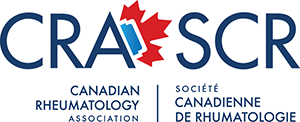Canadian Rheumatology Association (CRA) Position Statement on Medical Cannabis Use in Rheumatic Disease
Rheumatology patients experience prevalent pain that is only modestly controlled with current treatment strategies.
The CRA recognizes the need for improved pain relief in patients with rheumatic diseases. With the legalization of cannabis, Canadians are increasingly turning to their physicians for guidance regarding medical cannabis use, which has already entered mainstream medicine. Medical cannabis has not been subject to the standard review required for drug approval by Health Canada. In the absence of studies examining the effects of medical cannabis in patients with rheumatic diseases, rheumatologists should be prepared to offer pragmatic advice in a caring and empathetic way to ensure harm reduction.
Overarching principles for medical cannabis in rheumatology patients
- Medical cannabis is not an alternative to standard care for any rheumatic disease, and rheumatologists should adhere to current treatment standards and guidelines for rheumatic disease management.
- There are no published studies of the effects of medical cannabis in patients with rheumatic diseases and the few studies examining cannabinoid pharmaceutical products report limited benefits and high risk of adverse events.
- Medical cannabis should not be used in rheumatology patients under the age of 25 years.
- It is acknowledged that rheumatic disease patients may seek advice regarding use of medical cannabis, may currently be self-medicating with cannabis or may request a prescription for medical cannabis.
- Common reasons that patients may consider use of medical cannabis are for pain relief, improvement in mood and/or sleep promotion.
- Current treatment strategies for pain relief and sleep promotion, including non-pharmacologic treatments must be tried before consideration of trial of medical cannabis.
- Medical cannabis may provide symptom relief for some patients with rheumatic diseases.
- Short term adverse events (including immediate psychomotor effects, dizziness, appetite changes, effect on mood, and the rare serious side effects of disorientation and psychosis) are high with the use of medical cannabis and are likely to be similar to those reported for other disease populations.
- The long-term risks associated with medical cannabis in patients with rheumatic diseases are unknown.
- Despite a patient’s understanding of the lack of scientific evidence to support a benefit, and the potential increased risk of harms, some patients may choose a trial of medical cannabis over other options.
- Rheumatologists must endeavor to maintain an empathetic therapeutic relationship with their patients, avoid personal biases, and ensure harm reduction for both patients and society.
Table 1. Contraindications and cautions for medical cannabis
use
| 1. Medical cannabis should not be used in the following patient populations: |
|---|
|
| 2. Medical cannabis should be used with caution in the following patient populations: |
|
Table 2. When considering a trial of medical cannabis, the following should be addressed by the prescribing physician:
- The physician must have a full clinical knowledge of the patient including a clinical and psychosocial history, diagnosis of rheumatic disease, co-morbid medical and mental health diseases, reasons for considering medical cannabis, and concomitant medications.
- Treatment goals should be clearly discussed.
- Patients should be informed about the known adverse effects of cannabis, which include acute psychomotor impairment, potential lung injury when smoked, and addiction risk.
- Cannabis should not be smoked due to the toxic products of combustion. Inhalation via vaporizer or oral consumption is the preferred route of administration.
- Medical cannabis should be obtained from a licensed producer with known molecular content.
- Cannabis with a lower THC and higher CBD content is preferable.
- The ideal dosing schedule is not known but treatment should start with a nighttime dose and may be slowly increased to a maximum of 3 grams of medical cannabis (dried product or equivalent) a day.
- Patients should be followed within 4-8 weeks after initiating cannabis treatment.
- Cannabis treatment should be discontinued if there is absence of appreciable clinical effect or side effects that are substantial.
- Those continuing treatment should be evaluated at least every 3 months to assess efficacy and need to continue treatment.
Media/journalist enquiries
Please direct all media enquiries to info@rheum.ca or 905-952-0698 ext. 11.
| References |
|---|

